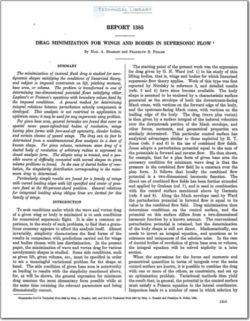NACA-Report-1385

- Version
- 163 Downloads
- 1.60 MB File Size
- 1 File Count
- December 4, 2015 Create Date
- December 4, 2015 Last Updated
National Advisory Committee for Aeronautics, Report - Drag Minimization for Wing and Bodies in Supersonic Flow

The minimization of inviscid fluid drag is studied for aero-
dynamic shapes satisfying the conditions of linearized theory,
and subject to imposed constraints on lift, pitching moment,
base area, or volume. The problem is transformed to one of
determining two—dimensional potential flows satisfying either
Laplace’s or Poisson’s equations with boundary values fired by
the imposed conditions. A general method for determining
integral relations between perturbation velocity components is
developed. This analysis is not restricted in application to
optimum cases; it may be used for any supersonic wing problem.
For given base area, general formulas are found that cover as
special cases quasi—cylindrical bodies of revolution, wings
having plan forms with fore-and-aft symmetry, slender bodies,
and certain classes of yawed wings. The drag can in fact be
determined from a unidimensional flow analysis in a duct of
known shape. For given volume, minimum wave drag of a
ducted body of revolution of arbitrary radius is expressed in
closed analytic form. The elliptic wing is treated, and a pos-
sible source of difliculty connected with unreal shapes in given
volume problems is found. In the case of ducted bodies of revo-
lution, the singularity distribution corresponding to the mini-
mum drag is determined.
Particularly simple results are found for a family of wings
with curved leading edges with lift specified and center of pres-
sure fired at the 60-percent-chord position. General relations
for integrated loading along oblique lines are derived for this
family of wings.
To seek conditions under which the wave and vortex drag
of a given wing or body is minimized is to seek conditions
for economical supersonic flight. It is also a common ex-
perience, in the study of such problems, to find that a gratu-
itous economy appears to affect the analysis itself. Almost
invariably, simplicity characterizes the final forms of the
results in comparison with predictions carried out for wings
and bodies chosen with less discrimination. In the present
paper, the minimization of wave and vortex drag for various
aerodynamic shapes is studied.
| File | Action |
|---|---|
| naca-report-1385.pdf | Download |

Comment On This Post